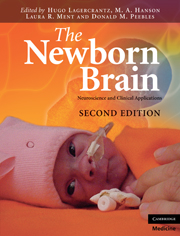Book contents
- Frontmatter
- Contents
- List of contributors
- Preface to the First Edition
- Preface to the Second Edition
- 1 Reflections on the origins of the human brain
- Section 1 Making of the brain
- Section 2 Sensory systems and behavior
- Section 3 Radiological and neurophysiological investigations
- 13 Imaging the neonatal brain
- 14 Electroencephalography and amplitude-integrated EEG
- 15 Emergence of spontaneous and evoked electroencephalographic activity in the human brain
- Section 4 Clinical aspects
- Section 5 Follow-up
- Section 6 Consciousness
- Index
- Plate section
- References
15 - Emergence of spontaneous and evoked electroencephalographic activity in the human brain
from Section 3 - Radiological and neurophysiological investigations
Published online by Cambridge University Press: 01 March 2011
- Frontmatter
- Contents
- List of contributors
- Preface to the First Edition
- Preface to the Second Edition
- 1 Reflections on the origins of the human brain
- Section 1 Making of the brain
- Section 2 Sensory systems and behavior
- Section 3 Radiological and neurophysiological investigations
- 13 Imaging the neonatal brain
- 14 Electroencephalography and amplitude-integrated EEG
- 15 Emergence of spontaneous and evoked electroencephalographic activity in the human brain
- Section 4 Clinical aspects
- Section 5 Follow-up
- Section 6 Consciousness
- Index
- Plate section
- References
Summary
Introduction
The adult human brain is estimated to contain about 1011 neurons with about 1000–10 000 synapses targeting each of them. This means that within each person's skull, there is a genuine microcosmos, in which the number of key elements (the ~1014 synapses) far exceeds the number of stars in our galaxy. The mere numbers above, however, provide only a faint picture of the true complexity of the brain, which is more accurately reflected in the microanatomical and functional specificity of the neuronal connections. The structural and functional specificity of wiring requires precise targeting of presynaptic endings to their proper postsynaptic locations at the subcellular level, and this has to be achieved for both local and distant connections in the course of brain development. In addition, the brain retains a high degree of structural and functional plasticity throughout an individual's lifetime, and therefore the wiring of neuronal networks is subject to control systems that maintain and also modify existing connections (Pascual-Leone et al., 2005). The plasticity of the brain is at its highest during development, and there is a massive literature describing various kinds of “sensitive” and “critical” periods during which the initial, preestablished connections show a heightened sensitivity to activity-induced modification (Katz & Crowley, 2002; Hooks & Chen, 2007).
Our genes total about 20 000 in number, and this has often been contrasted with the brain's complex phenotype to provide an argument against “genetic determinism” in brain development. However, this is not a valid comparison at all.
- Type
- Chapter
- Information
- The Newborn BrainNeuroscience and Clinical Applications, pp. 229 - 244Publisher: Cambridge University PressPrint publication year: 2010
References
- 9
- Cited by



